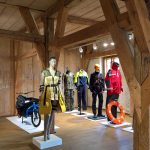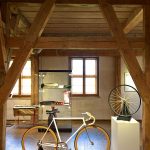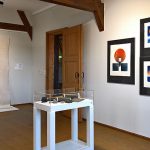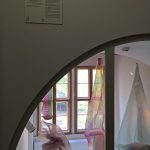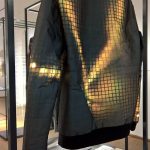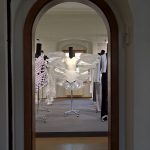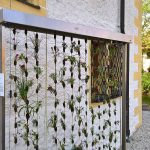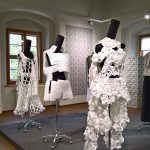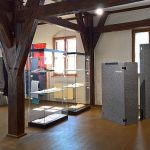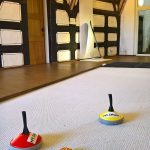New textile worlds in a creative context – Potential technical, intelligent textiles + smart materials at Wasserschloß Klaffenbach, Chemnitz
One of the principle motors of the development of new products is new materials: stone famously ceding its primacy to bronze, which in turn ceded to iron… to …. to …. to …. plastics; new materials not only allowing for new forms of objects, but for objects with new functionalities, new properties, new purposes, and thus objects both reflective of the new needs of a continually evolving society and also allowing those needs to be not only met but, ideally, exceeded, thus contributing to our social and cultural evolution.
With the exhibition New textile worlds in a creative context – Potential technical, intelligent textiles + smart materials the Wasserschloß Klaffenbach explores such relationships between materials and objects in context of both commercial products employing new materials technology and/or understandings and also academic research indicating possible future realities.
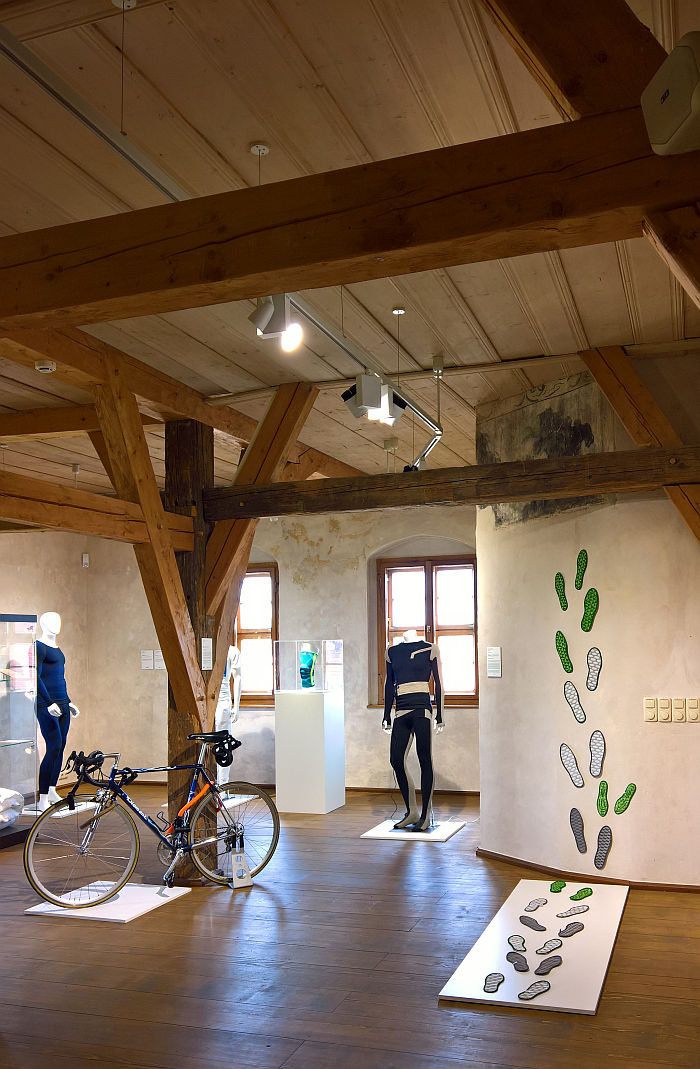
New textile worlds in a creative context – Potential technical, intelligent textiles + smart materials, Wasserschloß Klaffenbach, Chemnitz
Back in the day materials existed. They were natural, organic or mineral, and the skill lay in understanding their inherent properties and optimising them for a given purpose. Whereby the number of required purposes was notably less than today, life’s complexity having increased as it has progressed. And while today those same organic and mineral materials exist, and the challenges of optimally exploiting their inherent properties remains very much the same, new materials have been developed, and are being developed at ever more rapid rates; and not just synthetics, also a great many new materials based on new understandings and interpretations of the organic and the mineral that our forbearers didn’t, couldn’t, possess, and which thereby allow for a new array of technical, intelligent and smart materials.
However a new material is only part of the story, one also needs, designers, architects and craftsfolks, working interdisciplinary with engineers, academics, entrepreneurs, artists to develop meaningful uses for those new materials, be they new-new uses or new-old uses; or put another way, one must explore New textile worlds in a creative context. Whereby the prominent use of the word “textile” in the exhibition title implies a particular focus on one genre of material.
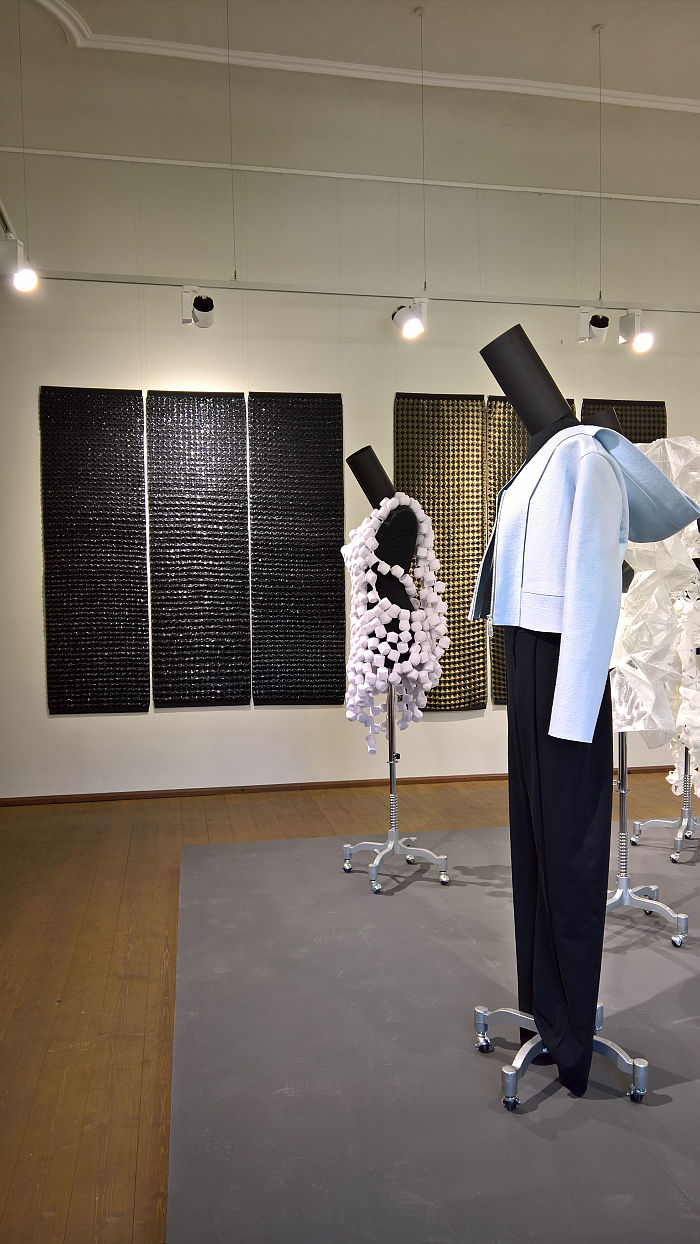
Works by Angewandte Kunst Schneeberg students, as seen at New textile worlds in a creative context – Potential technical, intelligent textiles + smart materials, Wasserschloß Klaffenbach, Chemnitz
Among the most logical, accepted, uses for textiles is clothing and luggage, and both feature prominently in New textile worlds in a creative context, including, and amongst many other projects, thermal underwear by Apolda based warmX which are not only zoned to match the specific needs of specific parts of the body but which can be selectively, actively, heated; a range of special use clothing for military, security and rescue services developed by Hohenstein-Ernstthal based Wattana; the AirSole insole collection by Eibenstock based Funke Stickerei, and a collection which includes insoles containing “infrared theads” which reflect the radiated heat of the foot back thereby helping keep your feet warmer in winter. Which, yes, sounds like witchcraft. Or the AkkuSafe etuis by Burkhardtsdorf based SGT which are designed to provide increased safety when transporting or charging lithium batteries, including preventing the risk of damage or injury should one explode. Thus underscoring that the rise in e-bikes not only requires new bike designs but new genres of accessories.
Cycling is considered in a couple of further projects including Chemnitz based Pi-Rope’s polyester wheel spokes and Leipzig based Tex-Lock’s textile bicycle lock, a product which neatly demonstrates how new materials allow for new formal and functional aspects of everyday objects, and, just as importantly, how the new can be playful and engaging as well as technical; while in terms of winter sports New textile worlds in a creative context features projects such as the Silbaerg snowboards developed, as previously discussed in these dispatches, in Chemnitz and at/in close cooperation with the city’s Technical University, and a synthetic ice rink/skiing mat developed and marketed by a Mr Snow from Chemnitz. Yes Mr Snow. And a man who automatically gave us the earworm Informer; meaning since visiting Klaffenbach our answer to every question has been “licky boom-boom down“. Which isn’t helpful. Or polite. On a more positive note you can break your visit to New textile worlds in a creative context with a spot of curling on Mr Snow’s textile ice rink
In addition the presentation features products as varied as, and amongst many, many others, Skarabeos rucksack with integrated anti-theft alarm created in Engerwitzdorf, Austria, basalt threads as an artistic tool as employed by Dresden based artist/designer TMVO Reimann or the modular Sysboard/Flex acoustic wall system by Leipzig based Studio Hartensteiner.
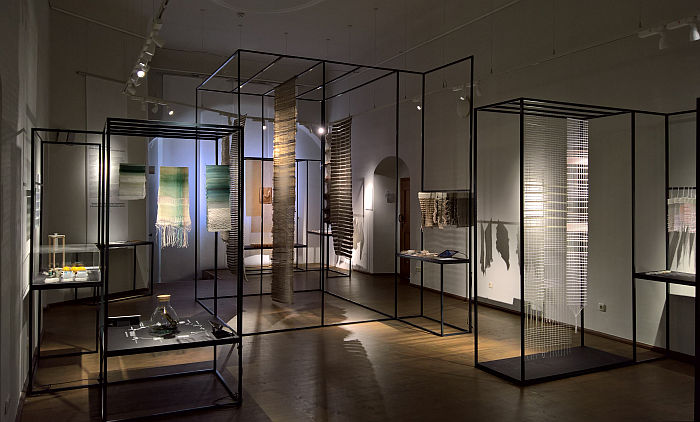
Works by Textile and Surface Design students, Weißensee Kunsthochschule Berlin, as seen at New textile worlds in a creative context – Potential technical, intelligent textiles + smart materials, Wasserschloß Klaffenbach, Chemnitz
As more observant, Sächsisch, readers will have noticed the vast majority of the companies represented in New textile worlds in a creative context are from Sachsen, and all, save a couple of exceptions, are from Sachsen and bordering Bundesländer. And thereby making the exhibition as much a review of the use of new materials by companies in Sachsen as it is about the materials themselves, and thereby allowing for reflections on contemporary industry in Sachsen. For all that Sachsen is home to innovative industries, and that the design and technology led industrial culture, for all the design and technology led textile industry culture, featured in Bauhaus_Sachsen at Grassi Museum für Angewandte Kunst Leipzig is very much still to be found. And as then, not just in the main centres, but in some highly improbable locations.
Similarly all the featured academic institutions are from, more or less, Sachsen, including the Technical University Chemnitz, Vitruvus Hochschule Leipzig, and the Angewandte Kunst Schneeberg, while from (slightly) further afield one finds students and staff from Burg Giebichenstein Halle and the Design and Experimental Material Research and Textile and Surface Design departments at the Weißensee Kunsthochschule Berlin, KHB.
Presenting a wide range of projects, and as one would want from designs schools, covering all bases from the conceptual over the experimental and onto more result orientated endeavours, the projects could be loosely/roughly split into those focussing primarily on process developments such as 3D printing or e-textiles and those more focussed on the materials such as Swantje Masermann’s Schneeberg Master Project exploring textiles which screen electromagnetic radiation in interiors; an interactive table cloth developed at Burg Halle to ease pensioners in their use of digital technology; or Juni Neyenhuys and Amlu Lücking’s consideration on alginate as a material for everyday goods as realised at the KHB. To name but three of many.
In addition New textile worlds in a creative context presents contributions from the network smart3 and the Sächsisches Textile Research Institute and thereby enabling a wide ranging and engaging presentation that helps approach understandings of contemporary materials, textiles, contemporary textiles research, and in doing so very neatly highlighting how today, certainly in comparison to previous generations, were are much more aware that materials aren’t passive components of a product but that they can be an active partner in helping us achieve the results we want. And that in our contemporary Anthropocene age we’re all too aware of our impact on the planet, of the need to rectify that, and the important role that materials play in that, be that through their origins, where they go when no longer needed or the processes and functions they enable and support and thereby their indirect impact, or lack of, on the environment and its resources.
And that achieving such in a meaningful way, achieving intelligent textiles + smart materials that are not only intelligent and smart in function but in concept, genesis, relevance and their integration into wider physical, natural, social and economic systems is a key challenge of our age. And one that can, and as with so much in life, be best achieved interdisciplinary.
New textile worlds in a creative context – Potential technical, intelligent textiles + smart materials runs at Wasserschloß Klaffenbach, Wasserschlossweg 6, 09123 Chemnitz, until Sunday June 30th
Full details, (German only), can be found at www.c3-chemnitz.de/Wasserschloss-Klaffenbach
- New textile worlds in a creative context – Potential technical, intelligent textiles + smart materials, Wasserschloß Klaffenbach, Chemnitz
- Pi-Rope synthetic spokes, as seen at New textile worlds in a creative context – Potential technical, intelligent textiles + smart materials, Wasserschloß Klaffenbach, Chemnitz
- New textile worlds in a creative context – Potential technical, intelligent textiles + smart materials, Wasserschloß Klaffenbach, Chemnitz
- Komplementaer by Theresa Kretsch, as seen at New textile worlds in a creative context – Potential technical, intelligent textiles + smart materials, Wasserschloß Klaffenbach, Chemnitz
- Screenstoffe by Veronika Aumann, as seen at New textile worlds in a creative context – Potential technical, intelligent textiles + smart materials, Wasserschloß Klaffenbach, Chemnitz
- Movement Still by Lena Spohn , as seen at New textile worlds in a creative context – Potential technical, intelligent textiles + smart materials, Wasserschloß Klaffenbach, Chemnitz
- silbaerg Shreddomat snowboard, as seen at New textile worlds in a creative context – Potential technical, intelligent textiles + smart materials, Wasserschloß Klaffenbach, Chemnitz
- Botanic Horizon, as seen at New textile worlds in a creative context – Potential technical, intelligent textiles + smart materials, Wasserschloß Klaffenbach, Chemnitz
- Tuchfühlung interavtive tablecloth, as seen at New textile worlds in a creative context – Potential technical, intelligent textiles + smart materials, Wasserschloß Klaffenbach, Chemnitz
- Works by Angewandte Kunst Schneeberg students, as seen at New textile worlds in a creative context – Potential technical, intelligent textiles + smart materials, Wasserschloß Klaffenbach, Chemnitz
- New textile worlds in a creative context – Potential technical, intelligent textiles + smart materials, Wasserschloß Klaffenbach, Chemnitz
- Mr Snow, as seen at New textile worlds in a creative context – Potential technical, intelligent textiles + smart materials, Wasserschloß Klaffenbach, Chemnitz
Tagged with: chemnitz, New textile worlds in a creative context, Sachsen, Textiles, Wasserschloß Klaffenbach
